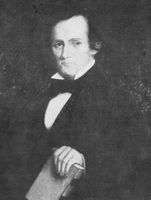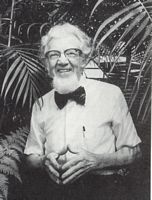Tulane University Herbarium (NO) History
Adapted from Bradburn, A.S. and S.P. Darwin. 1993. Type specimens of vascular plants at Tulane University, with a brief history of the Tulane Herbarium. Tulane Studies in Zoology and Botany 29: 73-95.
Established in the mid-nineteenth century and now integrated into the LSU collections, but keeping its original acronym
Origins of the Collection
The Tulane University Herbarium was established after the close of the New Orleans World's Industrial and Cotton Centennial Exposition of 1884-1885. Initially, all plant collections were part of the University Museum, which also had custody of a small herbarium belonging to the New Orleans Academy of Sciences founded in 1853. The Academy's herbarium includes some of the oldest existing Louisiana plant collections, these mostly gathered by early faculty of the Medical College of Louisiana (now Tulane University) in the 1840's. The most significant collectors who contributed to the Academy's and later the University's herbarium are mentioned below.
Josiah Hale, M.D. (1791-1856) was a Virginia native who settled near Alexandria, Louisiana, in 1825, after taking a medical degree at Transylvania College, there receiving botanical training from Rafinesque. He retired from medical practice in 1834, devoting full energy to botany. Torrey and Gray, in their Flora of North America (1838), frequently cite specimens obtained from Hale. Among his other correspondents were Riddell, Engelmann, Darlington, Leavenworth, Eaton, and Durand. Hale served as first President of the New Orleans Academy of Sciences, and the Hale specimens at Tulane, about one hundred, are from the Academy's herbarium (J. Ewan, J. Soc. Bibliogr. Nat. Hist. 8: 235-243. 1977).
John Leonard Riddell, M.D. (1807-1865), physician, scientist, and intellectual, arrived in New Orleans in 1836 as Professor of Chemistry at the Medical College of Louisiana. He subsequently held various professorships, including Pharmacy and Materia Medica. In 1839 he was appointed Melter and Refiner at the United States Branch Mint in New Orleans, and in 1860 Federal Postmaster, a position he held during the Civil War period. Riddell's interests extended to botany, mathematics, and invention, including an early typewriting machine, and the first practical binocular dissecting microscope. He was a charter member of the American Association for the Advancement of Science, and the New Orleans Academy of Sciences (K. Riess, Tulane Stud. Geol. Paleontol.13: 1-110. 1977).

John Leonard Riddell
– Tulane University's archive
Riddell began accumulating a herbarium in 1830 while at Marietta, Ohio, and contributed his first botanical paper in 1832. He had taken the bachelor's degree in 1829 at Rensselaer School with Amos Eaton, yet favored the taxonomic system of Jussieu over that of Linnaeus. He experimented with new methods of plant collecting, drying, and preservation; he exchanged specimens with Rafinesque and offered herbaria for sale. Riddell corresponded with the leading North American botanists, including Torrey, Engelmann, and Short. His paper A synopsis of the flora of the western states appeared in 1835, followed by A supplementary catalogue of Ohio plants in 1836. The Catalogus florae ludovicianae, abridged from a larger manuscript, appeared in 1852.
Riddell's specimens are widely distributed among North American and European herbaria; his personal herbarium, much damaged and depleted, was acquired by Charles Mohr, and is now in the U.S. National Herbarium, Smithsonian Institution. The Riddell specimens held at Tulane, mostly from Ohio and Louisiana, and numbering about 125, were part of the New Orleans Academy of Sciences herbarium, and frequently bear specimen labels in Riddell's hand.
William Marbury Carpenter, M.D. (1811-1848) was born in West Feliciana Parish, Louisiana. He attended West Point and served as Professor of Natural Sciences at Centenary College before joining the faculty of the Medical College of Louisiana in New Orleans as Professor of Materia Medica. In 1846, Carpenter and Charles Lyell made geological excursions in Louisiana, especially studying the Mississippi River delta. Carpenter's herbarium, except for specimens sent to Torrey and others, passed to Riddell, who donated a few dozen to the New Orleans Academy of Sciences (R.S. Cocks, Tulane Graduates' Mag. 3: 122-127. 1914).
Joseph Finley Joor, M.D. (1848-1892) was a native of Louisiana. He practiced medicine in New Orleans and Thibodaux, and then in Harrisburg and Birdston, Texas, before becoming Assistant Commissioner for Texas to prepare a botanical exhibit for the 1884-85 Cotton Centennial Exposition at New Orleans. In 1888 he assumed charge of Tulane University's Museum, first as Assistant Curator, and then Curator and Professor of Botany. A few hundred Joor specimens were incorporated into the New Orleans Academy of Sciences herbarium, of which he was also curator. His personal herbarium, which was not large, passed to the Missouri Botanical Garden in 1897. Tulane's Joor specimens, largely unduplicated at Missouri, are particularly rich in southern grasses, many specimens annotated by George Vasey (J.B.S. Norton, Bot. Gaz. 26: 271-274. 1898).
The Twentieth Century
Reginald W.S. Cocks, M.A. (1863-1926) was a native of Worcestershire, England. He took the master's degree at Trinity College, Cambridge, with first honors in classics. He was for a year Professor of Botany at Louisiana State University before moving in 1908 to assume the newly created Ida A. Richardson Chair of Botany at Tulane University. At about that time, Cocks began a correspondence with Charles Sprague Sargent, first Director of the Arnold Arboretum of Harvard University. In Cocks, Sargent found an able botanist and field companion on whom he could rely for data concerning the woody flora of the Gulf States. From Cocks's specimens, Sargent eventually recognized five new species or varieties of Carya, as well as new species of Quercus, Crataegus, and Tilia.
Cocks may have begun collecting plants as early as 1892, but in 1898 he initiated the first of many annual explorations that would, over a period of twenty-five years, take him to every part of Louisiana. The result was a sizeable herbarium and series of published inventories. For a few species, Cocks specimens remain the only Louisiana record. Many of his specimens carry identifications communicated by Sargent in a regular correspondence amounting to 302 letters now preserved in the University's archive (J. Ewan, J. Arnold Arbor. 46: 1-44, 122- 159, 324-361, 411-439. 1965).
Cocks was replaced on the Tulane faculty by William T. Penfound, Ph.D. (1897-1984). Although primarily a plant ecologist, Penfound and his graduate students gathered a number of Louisiana plant specimens, especially from local wetland habitats where ecological studies were being conducted. Those specimens now represent wetland vegetation existing before urban expansion in southern Louisiana, and voucher the numerous ecological studies published by Penfound and his co-workers.

Joseph Ewan
– Tulane University's archive
When Joseph Ewan, A.B., Sc.D. (Hon.) (1909-1999) came to Tulane in 1947, he brought with him a personal herbarium of some 32,000 specimens, probably three or four times as many specimens as were already present in the University's collection. The Ewan herbarium is largely responsible for the wide geographical coverage of the University's present collection, as well as many of its type specimens. In addition to his own collections, mostly from southern California, the Rocky Mountain region, and South America, Ewan's herbarium also included specimens gathered by L.M. Booth (southern California), I. Clokey (Nevada), D. Keck (Penstemon), J.G. Lemmon (California and Arizona ferns), F.W. Pierson (California), Y. Mexia (Latin America), and the Gray Herbarium exsiccatae of the Fernald period. Specimens of Delphinium and Vismia, Ewan's own taxonomic specialties, are also well represented.
The Tulane herbarium also benefitted from Ewan's interest in botanical history and bibliography; a number of specimens collected by well-known exploring expeditions of the nineteenth century were acquired from European herbaria, particularly The Natural History Museum, London, and the Conservatoire et Jardin Botaniques, Geneva. A nearly complete set of Asa Gray's North American Gramineae and Cyperaceae was also added. All collections were accommodated in modern steel cases, and curated by Nesta Dunn Ewan, who worked as a volunteer for thirty years.
Present Day
Since 1977, the curators attempted to enlarge the holdings of Louisiana plants, and acquire material from Mexico, particularly the Yucatan Peninsula, where studies were being carried out by Tulane faculty and students. To that end, a number of new exchange agreements were established with Latin American botanical institutions. Increased emphasis has also been placed upon cultivated plants in New Orleans. Staff included Steven P. Darwin, Ph.D., Director (taxonomy and phylogeny of angiosperms, tropical Rubiaceae, flora of Louisiana); Anne S. Bradburn, M.S., Curator (barrier island vegetation of the Gulf Coast, flora of Yucatan, ethnobotany); Arthur L. Welden, Ph.D., Curator (Neotropical fungi, especially Thelephoraceae). In 2000, the fungarium was transferred to The New York Botanical Garden. In 2016 Tulane University divested the herbarium and transferred the plant collections to the Shirley C. Tucker Herbarium at LSU, under the original acronym (NO).